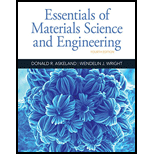
(a)
Interpretation:
The draw force needs to be calculated considering no friction of copper wire.
Concept Introduction:
Cold working is the
Answer to Problem 8.53P
The draw force required for original copper wire is 6096.65 N.
Explanation of Solution
Given Information:
1 inch = 2.54 cm
% cold work is given by the following relation:
Here,
Equation (1) becomes,
Thus at 30.56 % cold work from the graph yield strength of copper = 138 MPa.
Now, drag force (F) is calculated from the following formula,
Here,
Equation (2) becomes,
(b)
Interpretation:
Whether the drawn wire break in the drawing wire or not needs to be determined.
Concept Introduction:
Cold working is the mechanical process in which matrial is plastically deformed under recrystallization temperature.
Answer to Problem 8.53P
The stress after the wire is drawn under cold work is 198.71MPa which is less than actual yield strength 370MP. Hence wire will not break.
Explanation of Solution
Given Information:
1 inch = 2.54 cm
Thus drag force F of wire of copper is 6096.65 N
Final diameter = 0.625 cm
The stress (s) on the wire after cold work is given by the following relation:
Yield strength material will not break.
Want to see more full solutions like this?
Chapter 8 Solutions
Essentials Of Materials Science And Engineering
- Don't use ai to answer I will report you answerarrow_forwardIn javaarrow_forwardYou are asked to design a unit to condense ammonia. The required condensation rate is 0.09kg/s. Saturated ammonia at 30 o C is passed over a vertical plate (10 cm high and 25 cm wide).The properties of ammonia at the saturation temperature of 30°C are hfg = 1144 ́10^3 J/kg andrv = 9.055 kg/m 3 . Use the properties of liquid ammonia at the film temperature of 20°C (Ts =10 o C):Pr = 1.463 rho_l= 610.2 kf/m^3 liquid viscosity= 1.519*10^-4 kg/ ms kinematic viscosity= 2.489*10^-7 m^2/s Cpl= 4745 J/kg C kl=0.4927 W/m Ca)Calculate the surface temperature required to achieve the desired condensation rate of 0.09 kg/s( should be 688 degrees C) b) Show that if you use a bigger vertical plate (2.5 m-wide and 0.8 m-height), the requiredsurface temperature would be now 20 o C. You may use all the properties given as an initialguess. No need to iterate to correct for Tf. c) What if you still want to use small plates because of the space constrains? One way to getaround this problem is to use small…arrow_forward
- 1. The settling chamber, shown schematically in Figure 2E1.1, is used as a primary separation device in the removal of dust particles of density 1500 kg/m³ from a gas of density 0:7 kg/m³ and viscosity 1.90 x 10-5 Pa s. Gas inlet Elevation Gas Gas exit exit H Collection surface -W Section X-X Dimensions: H=3m L = 10 m W=2m Figure 2E1.1 Schematic diagram of settling chamber Assuming Stokes' law applies, show that the efficiency of collection of particles of size x is given by the expression collection efficiency, x = x²8(pp - Pi)L 18μHU where U is the uniform gas velocity through the parallel-sided section of the chamber. State any other assumptions made. (b) What is the upper limit of particle size for which Stokes' law applies? (c) When the volumetric flow rate of gas is 0.9 m³/s, and the dimensions of the chamber are those shown in Figure 2E1.1, determine the collection efficiency for spherical particles of diameter 30 mm.arrow_forwardQ3) using the following image matrix a- b- 12345 6 7 8 9 10 11 12 13 14 15 1617181920 21 22 23 24 25 Using direct chaotic one dimension method to convert the plain text to stego text (hello ahmed)? Using direct chaotic two-dimension method to convert the plain text to stego text?arrow_forwardIn famished depths, I pine upon my bed,Sweet thoughts of thy most holy meat and breadDrift through my mind like a beauty newlywed,So near yet so far be my true desireThe fridge stands there, nary ten feet away,Yet here I sprawl in lazy disarray,Too tired to move, I fall into dismayMy lust a tempest to my course most dire.O mustard bright! O pickles, crisp and tart!Thy sumptuous flesh a wonder of art!Thick cheddar slices beg my lips to part,Of thy essence never shall I tireNe’er to be surpassed in my inner heartThy taste alone doth lift me higherarrow_forward
- Can you answer this sequantially correct like show me the full process. Also, since it is chemical engineering related problem a perry's handbook is used. Thank youarrow_forwardQ1: I want his face in the shape of a balloon calculator Gray contains the addition of variables and a second box that shows the result and show it to be the solution of all mathematical equations in the language Python : 1- a a U ah ² (121 ²) + 20 (12132) = 10³² 12μ 12μ Where P P(x, y) is the oil film pressure. 2 ax 2- 3μU (L² P = C²R 4 ε sin (1+ε cos 0)³ 3arrow_forwardDon't use ai to answer I will report you answerarrow_forward
 MATLAB: An Introduction with ApplicationsEngineeringISBN:9781119256830Author:Amos GilatPublisher:John Wiley & Sons Inc
MATLAB: An Introduction with ApplicationsEngineeringISBN:9781119256830Author:Amos GilatPublisher:John Wiley & Sons Inc Essentials Of Materials Science And EngineeringEngineeringISBN:9781337385497Author:WRIGHT, Wendelin J.Publisher:Cengage,
Essentials Of Materials Science And EngineeringEngineeringISBN:9781337385497Author:WRIGHT, Wendelin J.Publisher:Cengage, Industrial Motor ControlEngineeringISBN:9781133691808Author:Stephen HermanPublisher:Cengage Learning
Industrial Motor ControlEngineeringISBN:9781133691808Author:Stephen HermanPublisher:Cengage Learning Basics Of Engineering EconomyEngineeringISBN:9780073376356Author:Leland Blank, Anthony TarquinPublisher:MCGRAW-HILL HIGHER EDUCATION
Basics Of Engineering EconomyEngineeringISBN:9780073376356Author:Leland Blank, Anthony TarquinPublisher:MCGRAW-HILL HIGHER EDUCATION Structural Steel Design (6th Edition)EngineeringISBN:9780134589657Author:Jack C. McCormac, Stephen F. CsernakPublisher:PEARSON
Structural Steel Design (6th Edition)EngineeringISBN:9780134589657Author:Jack C. McCormac, Stephen F. CsernakPublisher:PEARSON Fundamentals of Materials Science and Engineering...EngineeringISBN:9781119175483Author:William D. Callister Jr., David G. RethwischPublisher:WILEY
Fundamentals of Materials Science and Engineering...EngineeringISBN:9781119175483Author:William D. Callister Jr., David G. RethwischPublisher:WILEY





